University of Derby - Asthma Management Case Study in Clinic
VerifiedAdded on 2023/05/30
|19
|5555
|464
Case Study
AI Summary
This case study examines the management of an adult patient with moderate asthma at a community clinic by a general practice nurse, referencing current asthma status globally and utilizing expert knowledge, research, and GINA guidelines for nursing care. The case study details Esther's diagnosis of moderate persistent asthma, including clinical assessments using PEFR and spirometry tests, and her allergic rhinitis, with symptoms exacerbated by cold weather, dust, and smoke. Treatment involved ACT, low-dose ICS, and LABA inhalers, along with counseling on activity management. The study emphasizes the nurse's role in asthma management, focusing on patient education, self-management support, and effective communication to improve patient outcomes and adherence to treatment plans. After initial treatment and significant improvement, Esther was discharged with prescriptions and follow-up appointments, highlighting the importance of continuous care and self-management in asthma.
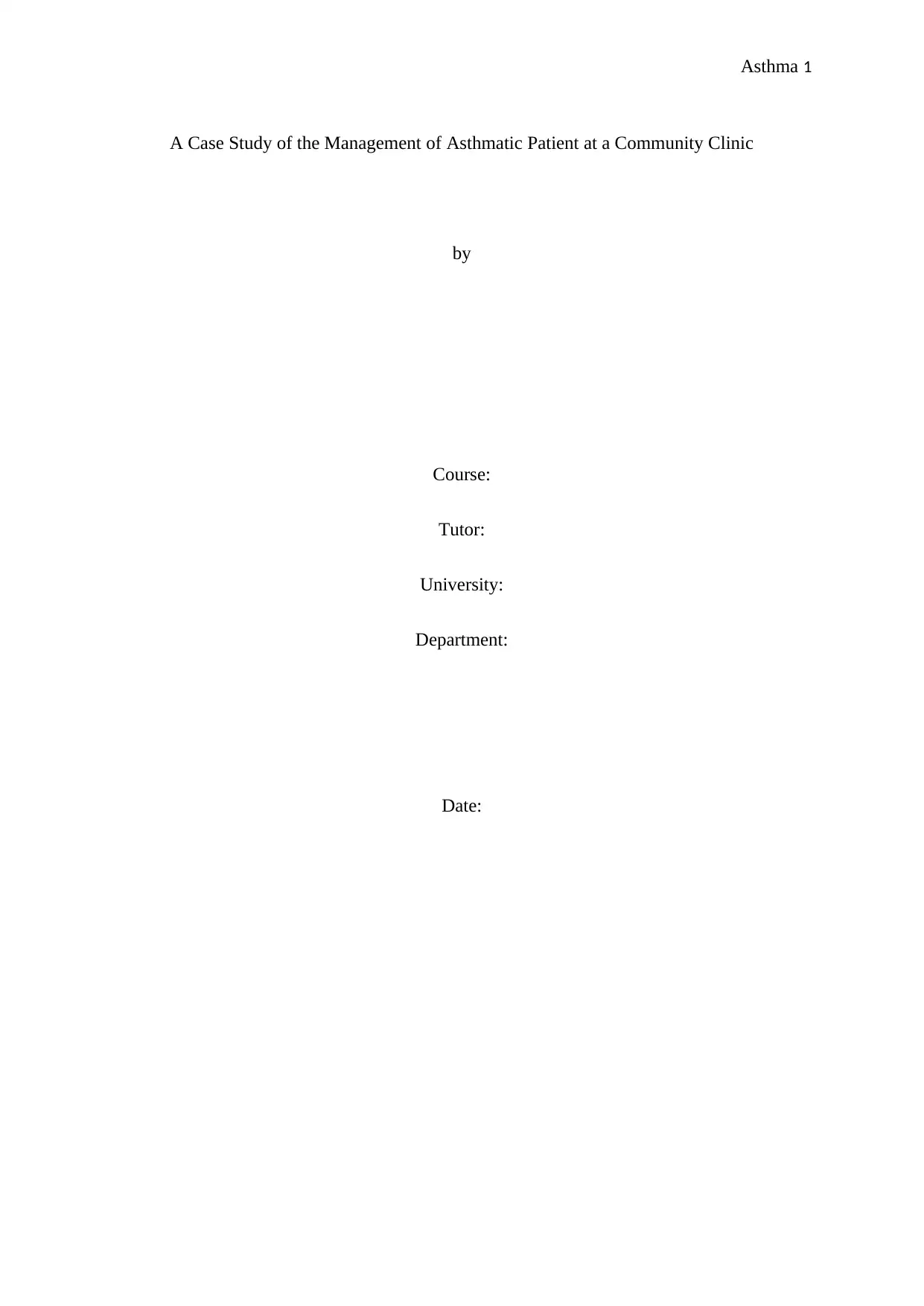
Asthma 1
A Case Study of the Management of Asthmatic Patient at a Community Clinic
by
Course:
Tutor:
University:
Department:
Date:
A Case Study of the Management of Asthmatic Patient at a Community Clinic
by
Course:
Tutor:
University:
Department:
Date:
Paraphrase This Document
Need a fresh take? Get an instant paraphrase of this document with our AI Paraphraser
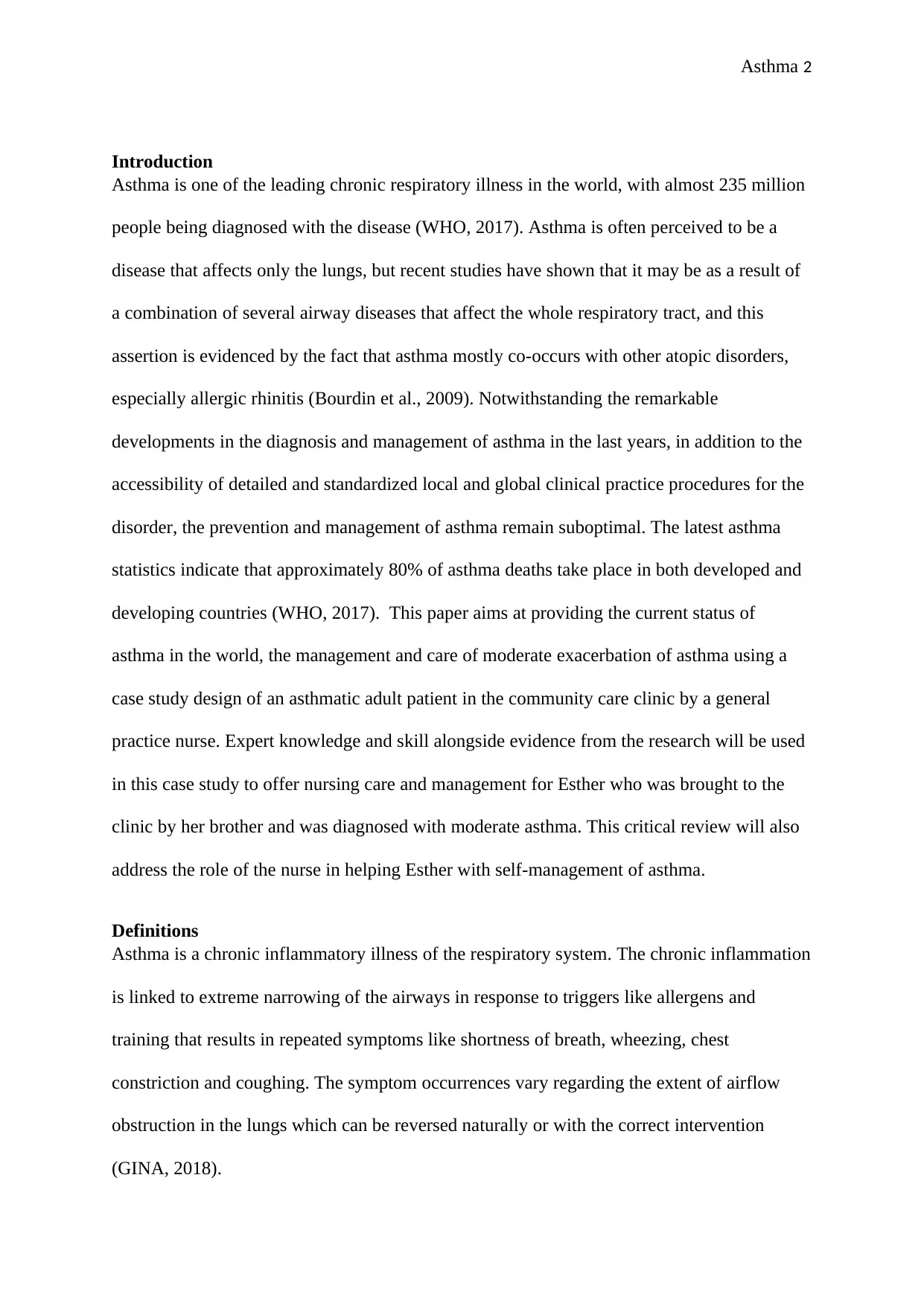
Asthma 2
Introduction
Asthma is one of the leading chronic respiratory illness in the world, with almost 235 million
people being diagnosed with the disease (WHO, 2017). Asthma is often perceived to be a
disease that affects only the lungs, but recent studies have shown that it may be as a result of
a combination of several airway diseases that affect the whole respiratory tract, and this
assertion is evidenced by the fact that asthma mostly co-occurs with other atopic disorders,
especially allergic rhinitis (Bourdin et al., 2009). Notwithstanding the remarkable
developments in the diagnosis and management of asthma in the last years, in addition to the
accessibility of detailed and standardized local and global clinical practice procedures for the
disorder, the prevention and management of asthma remain suboptimal. The latest asthma
statistics indicate that approximately 80% of asthma deaths take place in both developed and
developing countries (WHO, 2017). This paper aims at providing the current status of
asthma in the world, the management and care of moderate exacerbation of asthma using a
case study design of an asthmatic adult patient in the community care clinic by a general
practice nurse. Expert knowledge and skill alongside evidence from the research will be used
in this case study to offer nursing care and management for Esther who was brought to the
clinic by her brother and was diagnosed with moderate asthma. This critical review will also
address the role of the nurse in helping Esther with self-management of asthma.
Definitions
Asthma is a chronic inflammatory illness of the respiratory system. The chronic inflammation
is linked to extreme narrowing of the airways in response to triggers like allergens and
training that results in repeated symptoms like shortness of breath, wheezing, chest
constriction and coughing. The symptom occurrences vary regarding the extent of airflow
obstruction in the lungs which can be reversed naturally or with the correct intervention
(GINA, 2018).
Introduction
Asthma is one of the leading chronic respiratory illness in the world, with almost 235 million
people being diagnosed with the disease (WHO, 2017). Asthma is often perceived to be a
disease that affects only the lungs, but recent studies have shown that it may be as a result of
a combination of several airway diseases that affect the whole respiratory tract, and this
assertion is evidenced by the fact that asthma mostly co-occurs with other atopic disorders,
especially allergic rhinitis (Bourdin et al., 2009). Notwithstanding the remarkable
developments in the diagnosis and management of asthma in the last years, in addition to the
accessibility of detailed and standardized local and global clinical practice procedures for the
disorder, the prevention and management of asthma remain suboptimal. The latest asthma
statistics indicate that approximately 80% of asthma deaths take place in both developed and
developing countries (WHO, 2017). This paper aims at providing the current status of
asthma in the world, the management and care of moderate exacerbation of asthma using a
case study design of an asthmatic adult patient in the community care clinic by a general
practice nurse. Expert knowledge and skill alongside evidence from the research will be used
in this case study to offer nursing care and management for Esther who was brought to the
clinic by her brother and was diagnosed with moderate asthma. This critical review will also
address the role of the nurse in helping Esther with self-management of asthma.
Definitions
Asthma is a chronic inflammatory illness of the respiratory system. The chronic inflammation
is linked to extreme narrowing of the airways in response to triggers like allergens and
training that results in repeated symptoms like shortness of breath, wheezing, chest
constriction and coughing. The symptom occurrences vary regarding the extent of airflow
obstruction in the lungs which can be reversed naturally or with the correct intervention
(GINA, 2018).
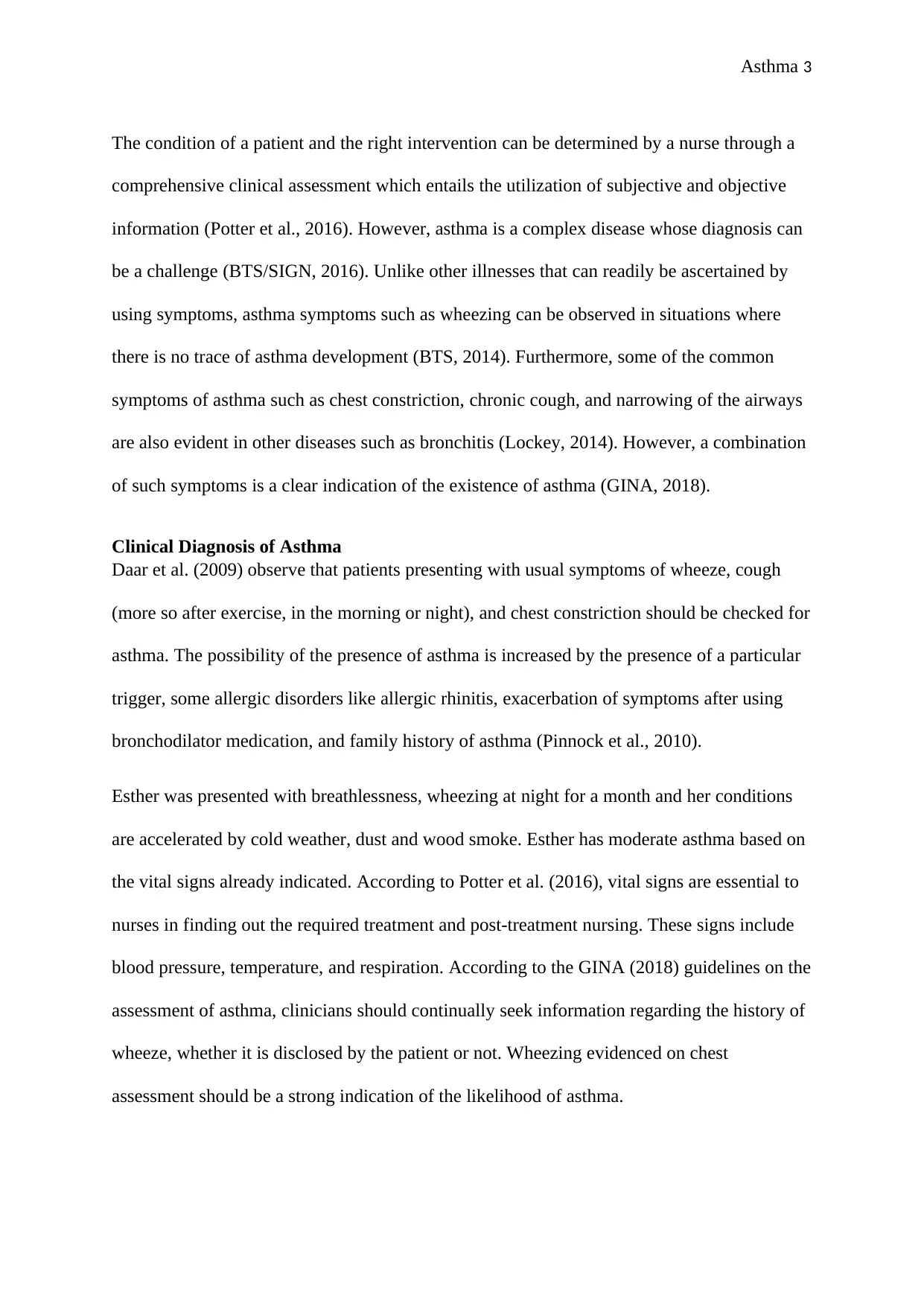
Asthma 3
The condition of a patient and the right intervention can be determined by a nurse through a
comprehensive clinical assessment which entails the utilization of subjective and objective
information (Potter et al., 2016). However, asthma is a complex disease whose diagnosis can
be a challenge (BTS/SIGN, 2016). Unlike other illnesses that can readily be ascertained by
using symptoms, asthma symptoms such as wheezing can be observed in situations where
there is no trace of asthma development (BTS, 2014). Furthermore, some of the common
symptoms of asthma such as chest constriction, chronic cough, and narrowing of the airways
are also evident in other diseases such as bronchitis (Lockey, 2014). However, a combination
of such symptoms is a clear indication of the existence of asthma (GINA, 2018).
Clinical Diagnosis of Asthma
Daar et al. (2009) observe that patients presenting with usual symptoms of wheeze, cough
(more so after exercise, in the morning or night), and chest constriction should be checked for
asthma. The possibility of the presence of asthma is increased by the presence of a particular
trigger, some allergic disorders like allergic rhinitis, exacerbation of symptoms after using
bronchodilator medication, and family history of asthma (Pinnock et al., 2010).
Esther was presented with breathlessness, wheezing at night for a month and her conditions
are accelerated by cold weather, dust and wood smoke. Esther has moderate asthma based on
the vital signs already indicated. According to Potter et al. (2016), vital signs are essential to
nurses in finding out the required treatment and post-treatment nursing. These signs include
blood pressure, temperature, and respiration. According to the GINA (2018) guidelines on the
assessment of asthma, clinicians should continually seek information regarding the history of
wheeze, whether it is disclosed by the patient or not. Wheezing evidenced on chest
assessment should be a strong indication of the likelihood of asthma.
The condition of a patient and the right intervention can be determined by a nurse through a
comprehensive clinical assessment which entails the utilization of subjective and objective
information (Potter et al., 2016). However, asthma is a complex disease whose diagnosis can
be a challenge (BTS/SIGN, 2016). Unlike other illnesses that can readily be ascertained by
using symptoms, asthma symptoms such as wheezing can be observed in situations where
there is no trace of asthma development (BTS, 2014). Furthermore, some of the common
symptoms of asthma such as chest constriction, chronic cough, and narrowing of the airways
are also evident in other diseases such as bronchitis (Lockey, 2014). However, a combination
of such symptoms is a clear indication of the existence of asthma (GINA, 2018).
Clinical Diagnosis of Asthma
Daar et al. (2009) observe that patients presenting with usual symptoms of wheeze, cough
(more so after exercise, in the morning or night), and chest constriction should be checked for
asthma. The possibility of the presence of asthma is increased by the presence of a particular
trigger, some allergic disorders like allergic rhinitis, exacerbation of symptoms after using
bronchodilator medication, and family history of asthma (Pinnock et al., 2010).
Esther was presented with breathlessness, wheezing at night for a month and her conditions
are accelerated by cold weather, dust and wood smoke. Esther has moderate asthma based on
the vital signs already indicated. According to Potter et al. (2016), vital signs are essential to
nurses in finding out the required treatment and post-treatment nursing. These signs include
blood pressure, temperature, and respiration. According to the GINA (2018) guidelines on the
assessment of asthma, clinicians should continually seek information regarding the history of
wheeze, whether it is disclosed by the patient or not. Wheezing evidenced on chest
assessment should be a strong indication of the likelihood of asthma.
⊘ This is a preview!⊘
Do you want full access?
Subscribe today to unlock all pages.

Trusted by 1+ million students worldwide
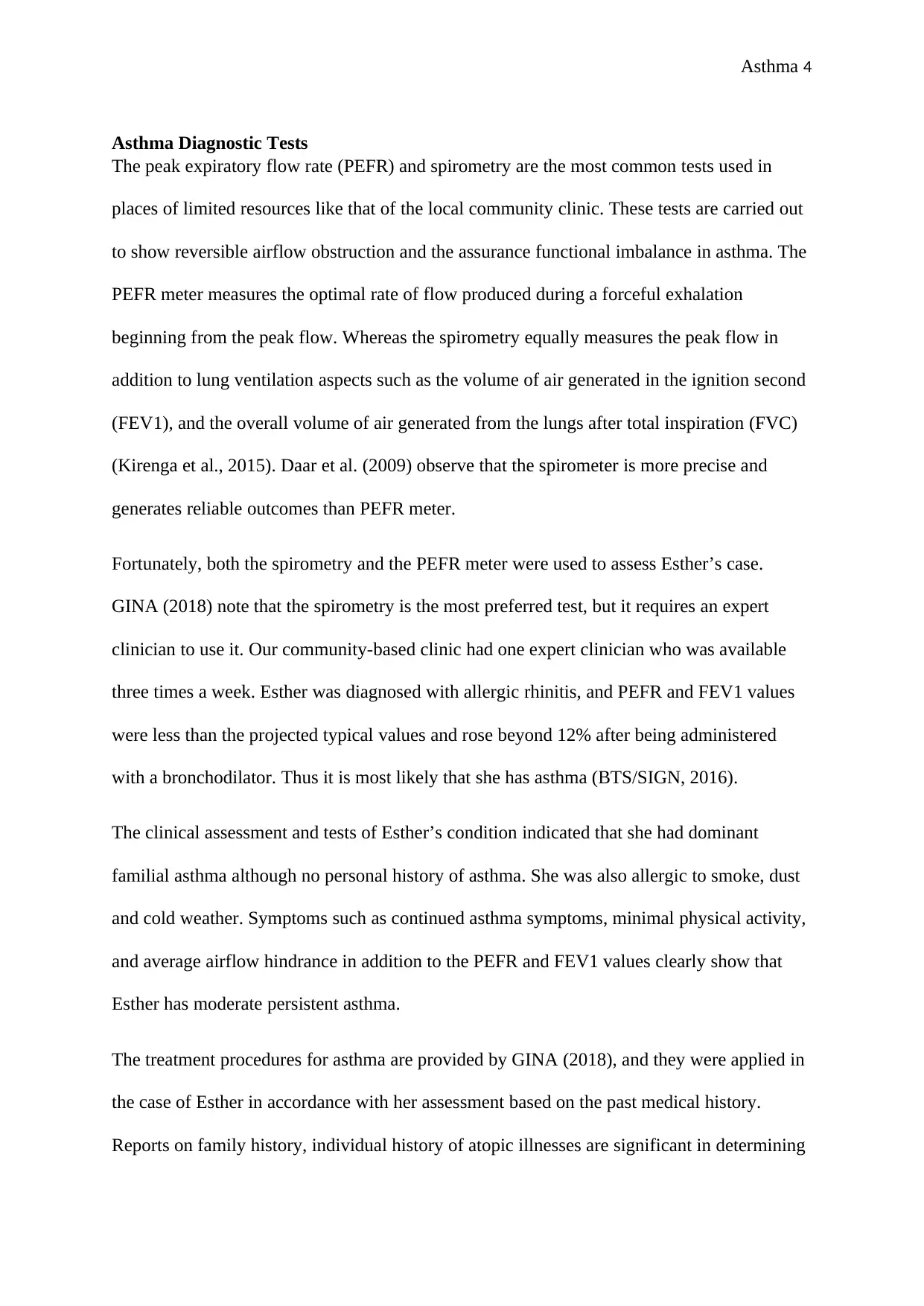
Asthma 4
Asthma Diagnostic Tests
The peak expiratory flow rate (PEFR) and spirometry are the most common tests used in
places of limited resources like that of the local community clinic. These tests are carried out
to show reversible airflow obstruction and the assurance functional imbalance in asthma. The
PEFR meter measures the optimal rate of flow produced during a forceful exhalation
beginning from the peak flow. Whereas the spirometry equally measures the peak flow in
addition to lung ventilation aspects such as the volume of air generated in the ignition second
(FEV1), and the overall volume of air generated from the lungs after total inspiration (FVC)
(Kirenga et al., 2015). Daar et al. (2009) observe that the spirometer is more precise and
generates reliable outcomes than PEFR meter.
Fortunately, both the spirometry and the PEFR meter were used to assess Esther’s case.
GINA (2018) note that the spirometry is the most preferred test, but it requires an expert
clinician to use it. Our community-based clinic had one expert clinician who was available
three times a week. Esther was diagnosed with allergic rhinitis, and PEFR and FEV1 values
were less than the projected typical values and rose beyond 12% after being administered
with a bronchodilator. Thus it is most likely that she has asthma (BTS/SIGN, 2016).
The clinical assessment and tests of Esther’s condition indicated that she had dominant
familial asthma although no personal history of asthma. She was also allergic to smoke, dust
and cold weather. Symptoms such as continued asthma symptoms, minimal physical activity,
and average airflow hindrance in addition to the PEFR and FEV1 values clearly show that
Esther has moderate persistent asthma.
The treatment procedures for asthma are provided by GINA (2018), and they were applied in
the case of Esther in accordance with her assessment based on the past medical history.
Reports on family history, individual history of atopic illnesses are significant in determining
Asthma Diagnostic Tests
The peak expiratory flow rate (PEFR) and spirometry are the most common tests used in
places of limited resources like that of the local community clinic. These tests are carried out
to show reversible airflow obstruction and the assurance functional imbalance in asthma. The
PEFR meter measures the optimal rate of flow produced during a forceful exhalation
beginning from the peak flow. Whereas the spirometry equally measures the peak flow in
addition to lung ventilation aspects such as the volume of air generated in the ignition second
(FEV1), and the overall volume of air generated from the lungs after total inspiration (FVC)
(Kirenga et al., 2015). Daar et al. (2009) observe that the spirometer is more precise and
generates reliable outcomes than PEFR meter.
Fortunately, both the spirometry and the PEFR meter were used to assess Esther’s case.
GINA (2018) note that the spirometry is the most preferred test, but it requires an expert
clinician to use it. Our community-based clinic had one expert clinician who was available
three times a week. Esther was diagnosed with allergic rhinitis, and PEFR and FEV1 values
were less than the projected typical values and rose beyond 12% after being administered
with a bronchodilator. Thus it is most likely that she has asthma (BTS/SIGN, 2016).
The clinical assessment and tests of Esther’s condition indicated that she had dominant
familial asthma although no personal history of asthma. She was also allergic to smoke, dust
and cold weather. Symptoms such as continued asthma symptoms, minimal physical activity,
and average airflow hindrance in addition to the PEFR and FEV1 values clearly show that
Esther has moderate persistent asthma.
The treatment procedures for asthma are provided by GINA (2018), and they were applied in
the case of Esther in accordance with her assessment based on the past medical history.
Reports on family history, individual history of atopic illnesses are significant in determining
Paraphrase This Document
Need a fresh take? Get an instant paraphrase of this document with our AI Paraphraser
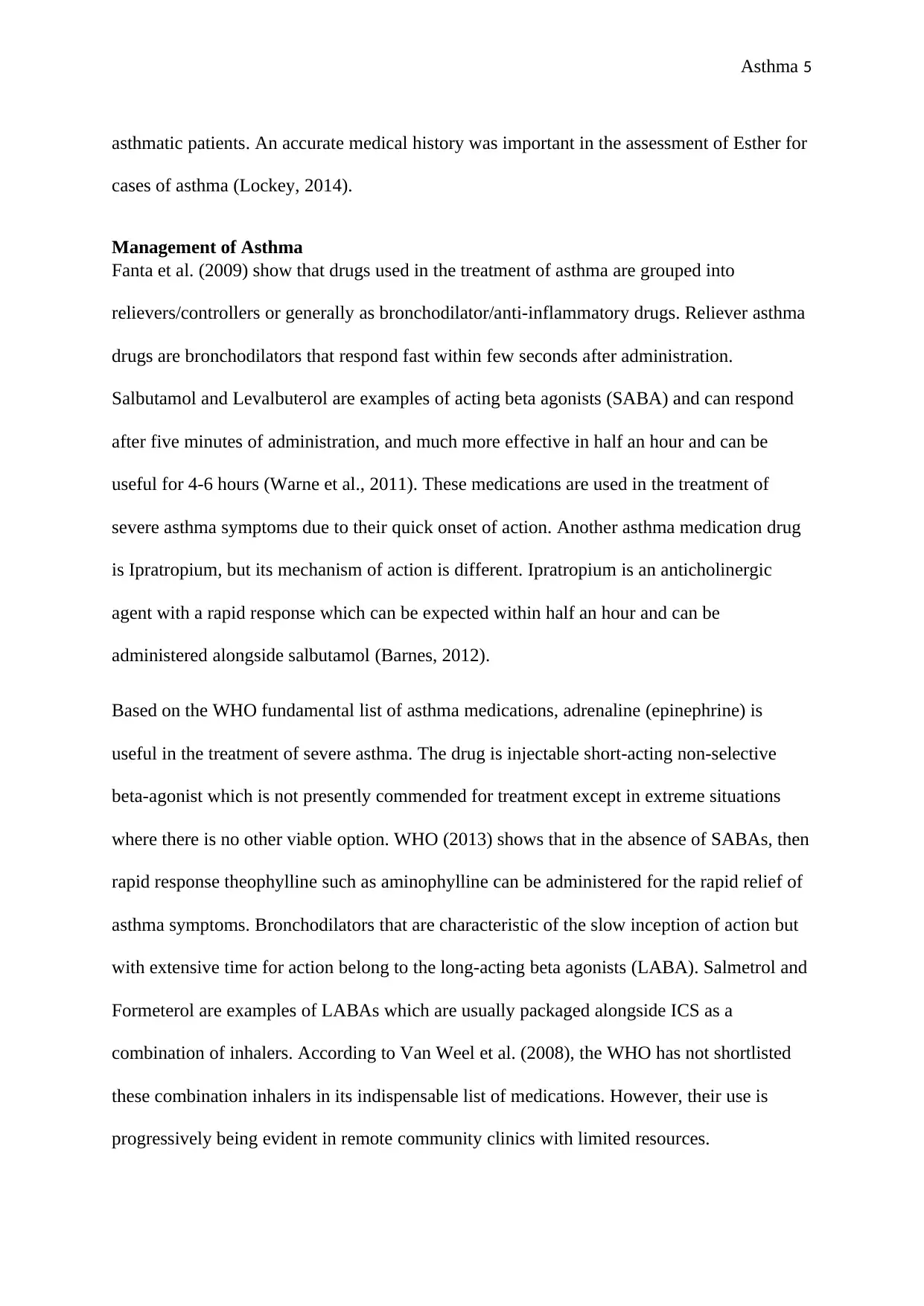
Asthma 5
asthmatic patients. An accurate medical history was important in the assessment of Esther for
cases of asthma (Lockey, 2014).
Management of Asthma
Fanta et al. (2009) show that drugs used in the treatment of asthma are grouped into
relievers/controllers or generally as bronchodilator/anti-inflammatory drugs. Reliever asthma
drugs are bronchodilators that respond fast within few seconds after administration.
Salbutamol and Levalbuterol are examples of acting beta agonists (SABA) and can respond
after five minutes of administration, and much more effective in half an hour and can be
useful for 4-6 hours (Warne et al., 2011). These medications are used in the treatment of
severe asthma symptoms due to their quick onset of action. Another asthma medication drug
is Ipratropium, but its mechanism of action is different. Ipratropium is an anticholinergic
agent with a rapid response which can be expected within half an hour and can be
administered alongside salbutamol (Barnes, 2012).
Based on the WHO fundamental list of asthma medications, adrenaline (epinephrine) is
useful in the treatment of severe asthma. The drug is injectable short-acting non-selective
beta-agonist which is not presently commended for treatment except in extreme situations
where there is no other viable option. WHO (2013) shows that in the absence of SABAs, then
rapid response theophylline such as aminophylline can be administered for the rapid relief of
asthma symptoms. Bronchodilators that are characteristic of the slow inception of action but
with extensive time for action belong to the long-acting beta agonists (LABA). Salmetrol and
Formeterol are examples of LABAs which are usually packaged alongside ICS as a
combination of inhalers. According to Van Weel et al. (2008), the WHO has not shortlisted
these combination inhalers in its indispensable list of medications. However, their use is
progressively being evident in remote community clinics with limited resources.
asthmatic patients. An accurate medical history was important in the assessment of Esther for
cases of asthma (Lockey, 2014).
Management of Asthma
Fanta et al. (2009) show that drugs used in the treatment of asthma are grouped into
relievers/controllers or generally as bronchodilator/anti-inflammatory drugs. Reliever asthma
drugs are bronchodilators that respond fast within few seconds after administration.
Salbutamol and Levalbuterol are examples of acting beta agonists (SABA) and can respond
after five minutes of administration, and much more effective in half an hour and can be
useful for 4-6 hours (Warne et al., 2011). These medications are used in the treatment of
severe asthma symptoms due to their quick onset of action. Another asthma medication drug
is Ipratropium, but its mechanism of action is different. Ipratropium is an anticholinergic
agent with a rapid response which can be expected within half an hour and can be
administered alongside salbutamol (Barnes, 2012).
Based on the WHO fundamental list of asthma medications, adrenaline (epinephrine) is
useful in the treatment of severe asthma. The drug is injectable short-acting non-selective
beta-agonist which is not presently commended for treatment except in extreme situations
where there is no other viable option. WHO (2013) shows that in the absence of SABAs, then
rapid response theophylline such as aminophylline can be administered for the rapid relief of
asthma symptoms. Bronchodilators that are characteristic of the slow inception of action but
with extensive time for action belong to the long-acting beta agonists (LABA). Salmetrol and
Formeterol are examples of LABAs which are usually packaged alongside ICS as a
combination of inhalers. According to Van Weel et al. (2008), the WHO has not shortlisted
these combination inhalers in its indispensable list of medications. However, their use is
progressively being evident in remote community clinics with limited resources.
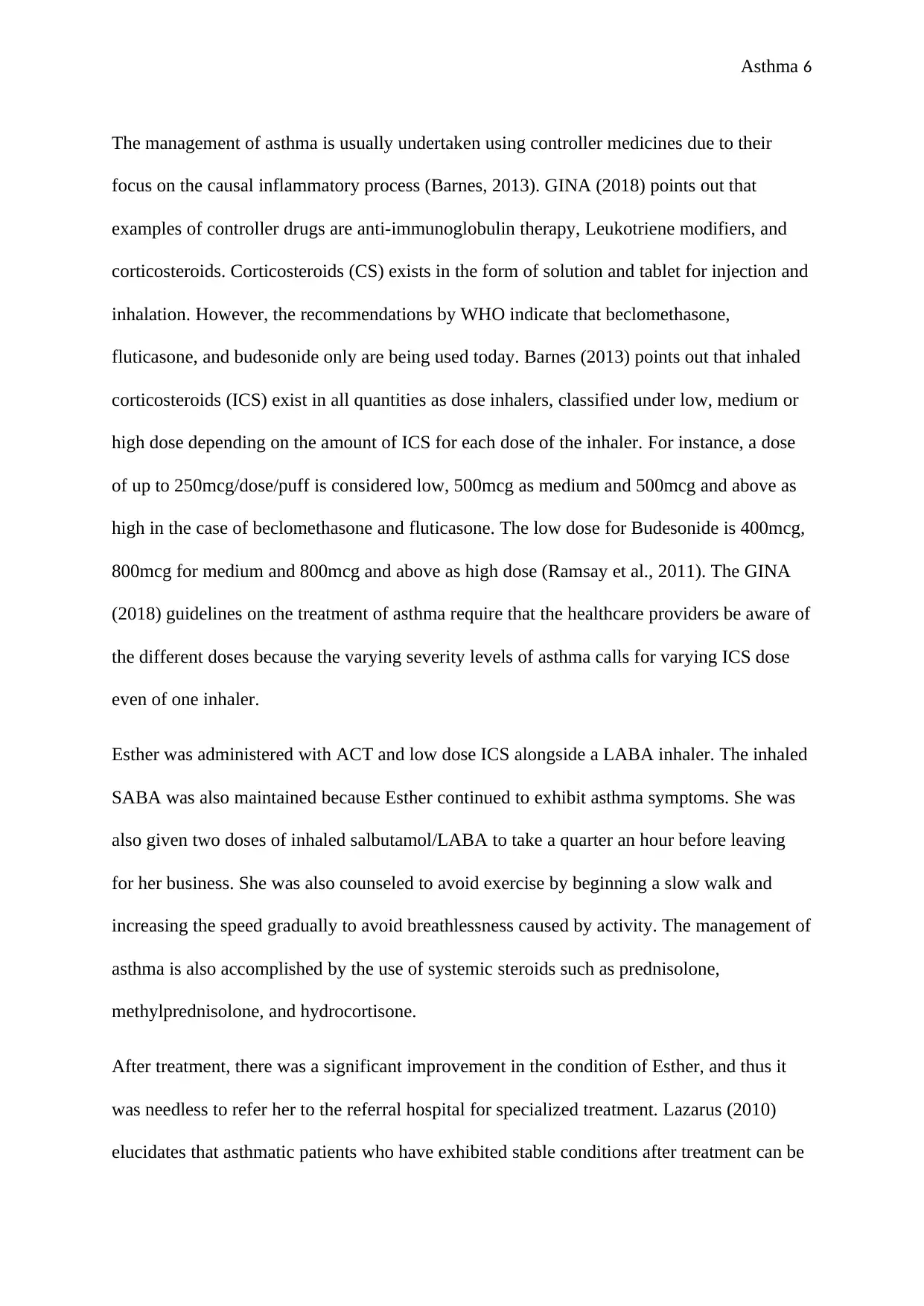
Asthma 6
The management of asthma is usually undertaken using controller medicines due to their
focus on the causal inflammatory process (Barnes, 2013). GINA (2018) points out that
examples of controller drugs are anti-immunoglobulin therapy, Leukotriene modifiers, and
corticosteroids. Corticosteroids (CS) exists in the form of solution and tablet for injection and
inhalation. However, the recommendations by WHO indicate that beclomethasone,
fluticasone, and budesonide only are being used today. Barnes (2013) points out that inhaled
corticosteroids (ICS) exist in all quantities as dose inhalers, classified under low, medium or
high dose depending on the amount of ICS for each dose of the inhaler. For instance, a dose
of up to 250mcg/dose/puff is considered low, 500mcg as medium and 500mcg and above as
high in the case of beclomethasone and fluticasone. The low dose for Budesonide is 400mcg,
800mcg for medium and 800mcg and above as high dose (Ramsay et al., 2011). The GINA
(2018) guidelines on the treatment of asthma require that the healthcare providers be aware of
the different doses because the varying severity levels of asthma calls for varying ICS dose
even of one inhaler.
Esther was administered with ACT and low dose ICS alongside a LABA inhaler. The inhaled
SABA was also maintained because Esther continued to exhibit asthma symptoms. She was
also given two doses of inhaled salbutamol/LABA to take a quarter an hour before leaving
for her business. She was also counseled to avoid exercise by beginning a slow walk and
increasing the speed gradually to avoid breathlessness caused by activity. The management of
asthma is also accomplished by the use of systemic steroids such as prednisolone,
methylprednisolone, and hydrocortisone.
After treatment, there was a significant improvement in the condition of Esther, and thus it
was needless to refer her to the referral hospital for specialized treatment. Lazarus (2010)
elucidates that asthmatic patients who have exhibited stable conditions after treatment can be
The management of asthma is usually undertaken using controller medicines due to their
focus on the causal inflammatory process (Barnes, 2013). GINA (2018) points out that
examples of controller drugs are anti-immunoglobulin therapy, Leukotriene modifiers, and
corticosteroids. Corticosteroids (CS) exists in the form of solution and tablet for injection and
inhalation. However, the recommendations by WHO indicate that beclomethasone,
fluticasone, and budesonide only are being used today. Barnes (2013) points out that inhaled
corticosteroids (ICS) exist in all quantities as dose inhalers, classified under low, medium or
high dose depending on the amount of ICS for each dose of the inhaler. For instance, a dose
of up to 250mcg/dose/puff is considered low, 500mcg as medium and 500mcg and above as
high in the case of beclomethasone and fluticasone. The low dose for Budesonide is 400mcg,
800mcg for medium and 800mcg and above as high dose (Ramsay et al., 2011). The GINA
(2018) guidelines on the treatment of asthma require that the healthcare providers be aware of
the different doses because the varying severity levels of asthma calls for varying ICS dose
even of one inhaler.
Esther was administered with ACT and low dose ICS alongside a LABA inhaler. The inhaled
SABA was also maintained because Esther continued to exhibit asthma symptoms. She was
also given two doses of inhaled salbutamol/LABA to take a quarter an hour before leaving
for her business. She was also counseled to avoid exercise by beginning a slow walk and
increasing the speed gradually to avoid breathlessness caused by activity. The management of
asthma is also accomplished by the use of systemic steroids such as prednisolone,
methylprednisolone, and hydrocortisone.
After treatment, there was a significant improvement in the condition of Esther, and thus it
was needless to refer her to the referral hospital for specialized treatment. Lazarus (2010)
elucidates that asthmatic patients who have exhibited stable conditions after treatment can be
⊘ This is a preview!⊘
Do you want full access?
Subscribe today to unlock all pages.

Trusted by 1+ million students worldwide
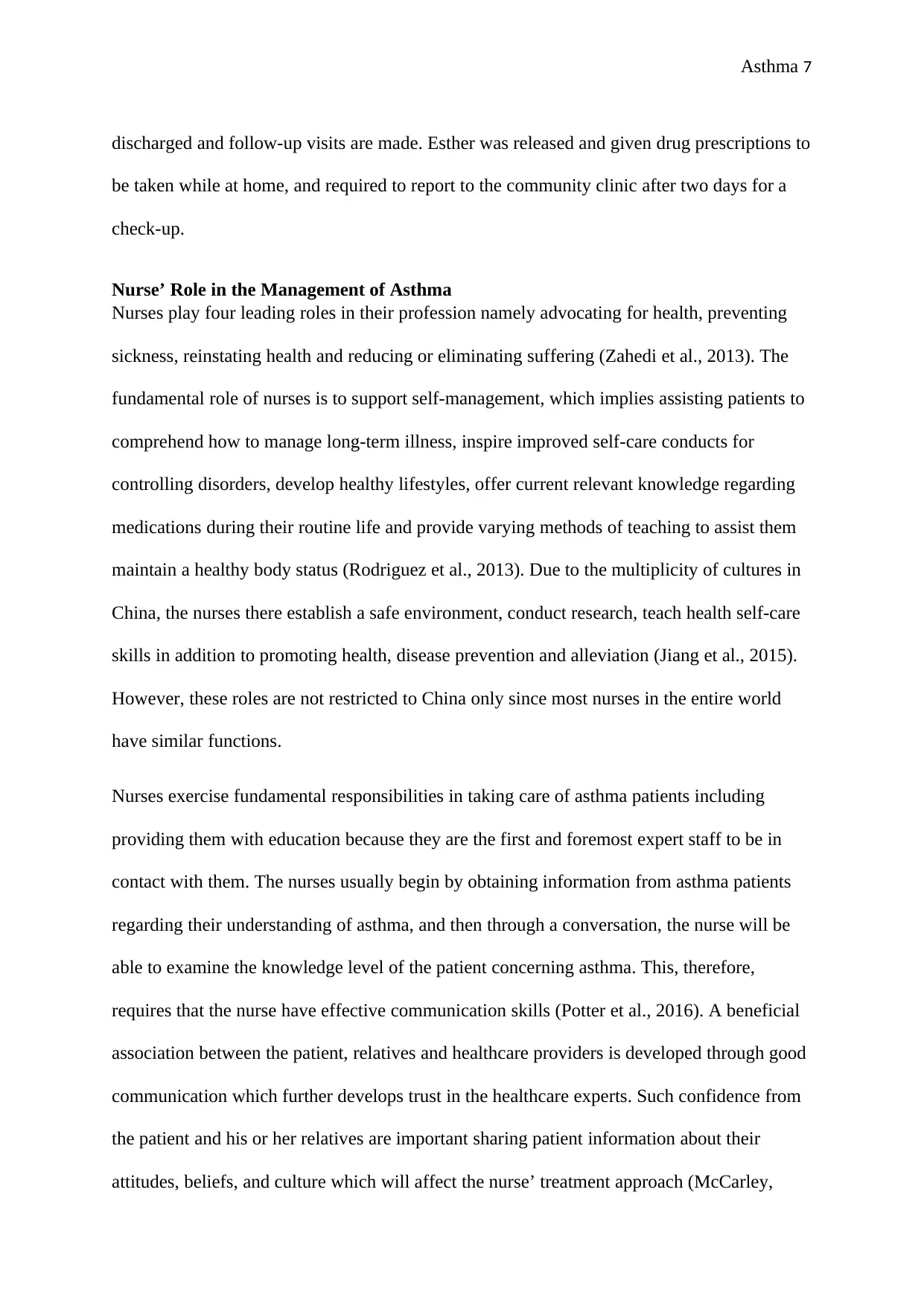
Asthma 7
discharged and follow-up visits are made. Esther was released and given drug prescriptions to
be taken while at home, and required to report to the community clinic after two days for a
check-up.
Nurse’ Role in the Management of Asthma
Nurses play four leading roles in their profession namely advocating for health, preventing
sickness, reinstating health and reducing or eliminating suffering (Zahedi et al., 2013). The
fundamental role of nurses is to support self-management, which implies assisting patients to
comprehend how to manage long-term illness, inspire improved self-care conducts for
controlling disorders, develop healthy lifestyles, offer current relevant knowledge regarding
medications during their routine life and provide varying methods of teaching to assist them
maintain a healthy body status (Rodriguez et al., 2013). Due to the multiplicity of cultures in
China, the nurses there establish a safe environment, conduct research, teach health self-care
skills in addition to promoting health, disease prevention and alleviation (Jiang et al., 2015).
However, these roles are not restricted to China only since most nurses in the entire world
have similar functions.
Nurses exercise fundamental responsibilities in taking care of asthma patients including
providing them with education because they are the first and foremost expert staff to be in
contact with them. The nurses usually begin by obtaining information from asthma patients
regarding their understanding of asthma, and then through a conversation, the nurse will be
able to examine the knowledge level of the patient concerning asthma. This, therefore,
requires that the nurse have effective communication skills (Potter et al., 2016). A beneficial
association between the patient, relatives and healthcare providers is developed through good
communication which further develops trust in the healthcare experts. Such confidence from
the patient and his or her relatives are important sharing patient information about their
attitudes, beliefs, and culture which will affect the nurse’ treatment approach (McCarley,
discharged and follow-up visits are made. Esther was released and given drug prescriptions to
be taken while at home, and required to report to the community clinic after two days for a
check-up.
Nurse’ Role in the Management of Asthma
Nurses play four leading roles in their profession namely advocating for health, preventing
sickness, reinstating health and reducing or eliminating suffering (Zahedi et al., 2013). The
fundamental role of nurses is to support self-management, which implies assisting patients to
comprehend how to manage long-term illness, inspire improved self-care conducts for
controlling disorders, develop healthy lifestyles, offer current relevant knowledge regarding
medications during their routine life and provide varying methods of teaching to assist them
maintain a healthy body status (Rodriguez et al., 2013). Due to the multiplicity of cultures in
China, the nurses there establish a safe environment, conduct research, teach health self-care
skills in addition to promoting health, disease prevention and alleviation (Jiang et al., 2015).
However, these roles are not restricted to China only since most nurses in the entire world
have similar functions.
Nurses exercise fundamental responsibilities in taking care of asthma patients including
providing them with education because they are the first and foremost expert staff to be in
contact with them. The nurses usually begin by obtaining information from asthma patients
regarding their understanding of asthma, and then through a conversation, the nurse will be
able to examine the knowledge level of the patient concerning asthma. This, therefore,
requires that the nurse have effective communication skills (Potter et al., 2016). A beneficial
association between the patient, relatives and healthcare providers is developed through good
communication which further develops trust in the healthcare experts. Such confidence from
the patient and his or her relatives are important sharing patient information about their
attitudes, beliefs, and culture which will affect the nurse’ treatment approach (McCarley,
Paraphrase This Document
Need a fresh take? Get an instant paraphrase of this document with our AI Paraphraser
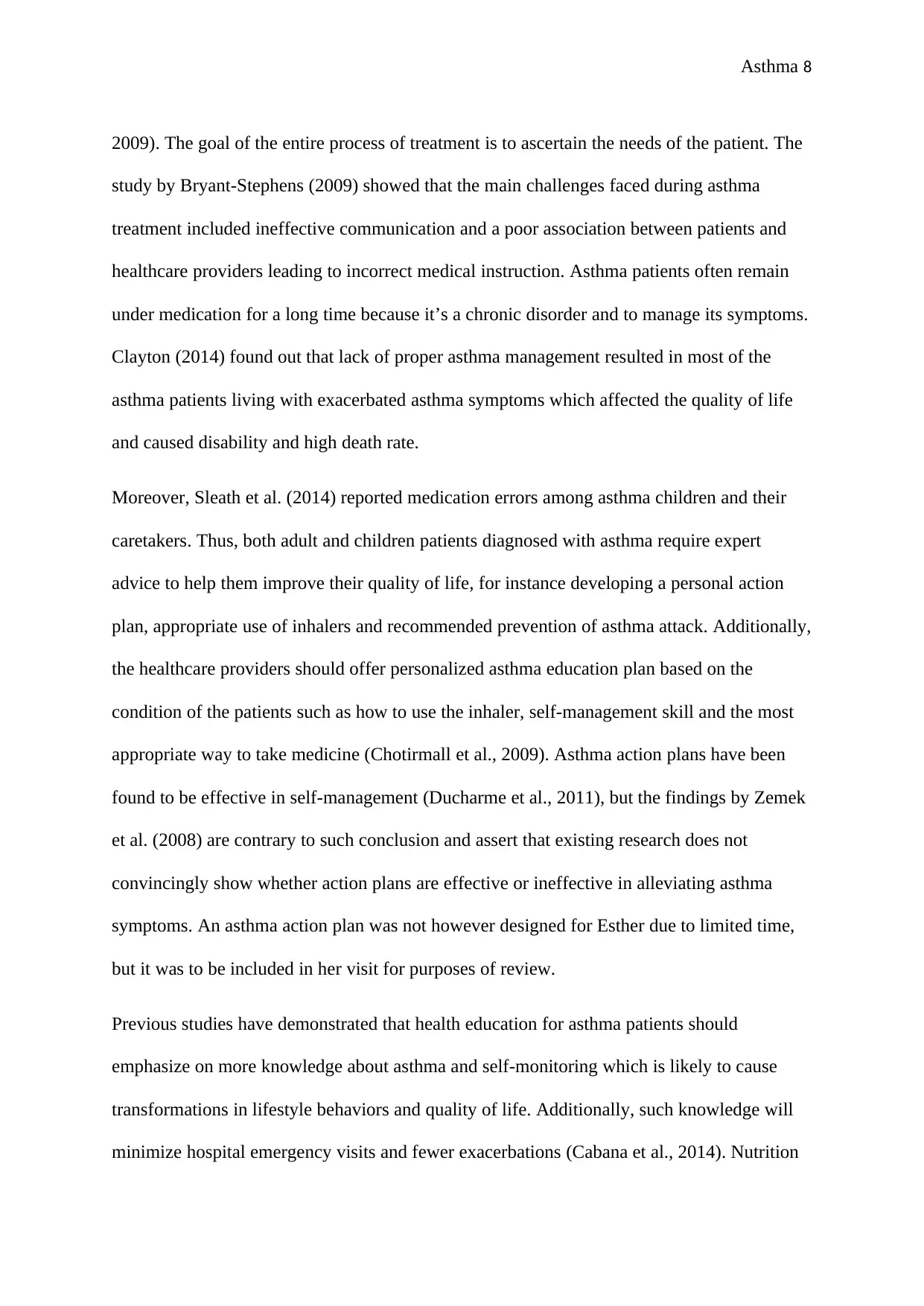
Asthma 8
2009). The goal of the entire process of treatment is to ascertain the needs of the patient. The
study by Bryant-Stephens (2009) showed that the main challenges faced during asthma
treatment included ineffective communication and a poor association between patients and
healthcare providers leading to incorrect medical instruction. Asthma patients often remain
under medication for a long time because it’s a chronic disorder and to manage its symptoms.
Clayton (2014) found out that lack of proper asthma management resulted in most of the
asthma patients living with exacerbated asthma symptoms which affected the quality of life
and caused disability and high death rate.
Moreover, Sleath et al. (2014) reported medication errors among asthma children and their
caretakers. Thus, both adult and children patients diagnosed with asthma require expert
advice to help them improve their quality of life, for instance developing a personal action
plan, appropriate use of inhalers and recommended prevention of asthma attack. Additionally,
the healthcare providers should offer personalized asthma education plan based on the
condition of the patients such as how to use the inhaler, self-management skill and the most
appropriate way to take medicine (Chotirmall et al., 2009). Asthma action plans have been
found to be effective in self-management (Ducharme et al., 2011), but the findings by Zemek
et al. (2008) are contrary to such conclusion and assert that existing research does not
convincingly show whether action plans are effective or ineffective in alleviating asthma
symptoms. An asthma action plan was not however designed for Esther due to limited time,
but it was to be included in her visit for purposes of review.
Previous studies have demonstrated that health education for asthma patients should
emphasize on more knowledge about asthma and self-monitoring which is likely to cause
transformations in lifestyle behaviors and quality of life. Additionally, such knowledge will
minimize hospital emergency visits and fewer exacerbations (Cabana et al., 2014). Nutrition
2009). The goal of the entire process of treatment is to ascertain the needs of the patient. The
study by Bryant-Stephens (2009) showed that the main challenges faced during asthma
treatment included ineffective communication and a poor association between patients and
healthcare providers leading to incorrect medical instruction. Asthma patients often remain
under medication for a long time because it’s a chronic disorder and to manage its symptoms.
Clayton (2014) found out that lack of proper asthma management resulted in most of the
asthma patients living with exacerbated asthma symptoms which affected the quality of life
and caused disability and high death rate.
Moreover, Sleath et al. (2014) reported medication errors among asthma children and their
caretakers. Thus, both adult and children patients diagnosed with asthma require expert
advice to help them improve their quality of life, for instance developing a personal action
plan, appropriate use of inhalers and recommended prevention of asthma attack. Additionally,
the healthcare providers should offer personalized asthma education plan based on the
condition of the patients such as how to use the inhaler, self-management skill and the most
appropriate way to take medicine (Chotirmall et al., 2009). Asthma action plans have been
found to be effective in self-management (Ducharme et al., 2011), but the findings by Zemek
et al. (2008) are contrary to such conclusion and assert that existing research does not
convincingly show whether action plans are effective or ineffective in alleviating asthma
symptoms. An asthma action plan was not however designed for Esther due to limited time,
but it was to be included in her visit for purposes of review.
Previous studies have demonstrated that health education for asthma patients should
emphasize on more knowledge about asthma and self-monitoring which is likely to cause
transformations in lifestyle behaviors and quality of life. Additionally, such knowledge will
minimize hospital emergency visits and fewer exacerbations (Cabana et al., 2014). Nutrition
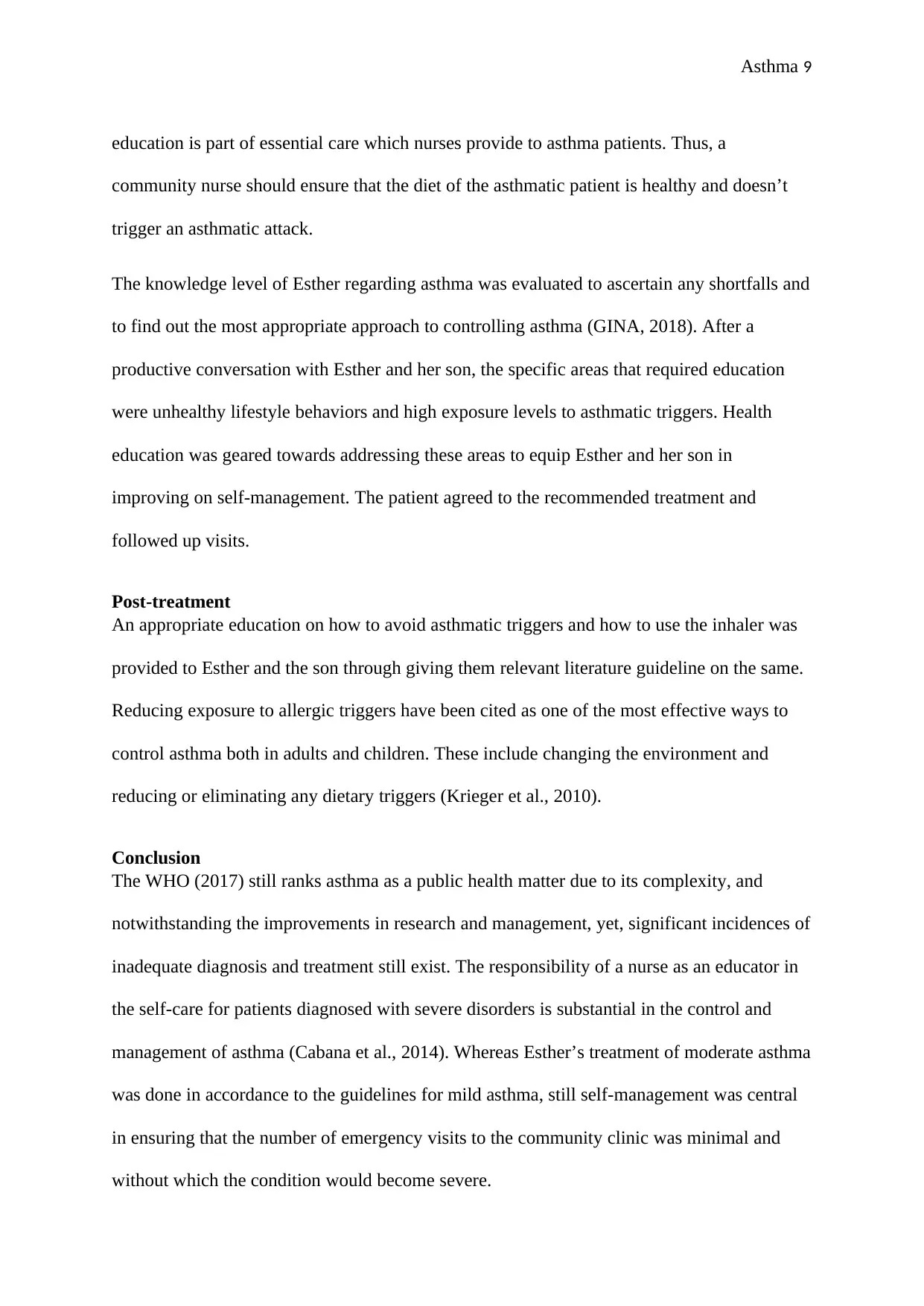
Asthma 9
education is part of essential care which nurses provide to asthma patients. Thus, a
community nurse should ensure that the diet of the asthmatic patient is healthy and doesn’t
trigger an asthmatic attack.
The knowledge level of Esther regarding asthma was evaluated to ascertain any shortfalls and
to find out the most appropriate approach to controlling asthma (GINA, 2018). After a
productive conversation with Esther and her son, the specific areas that required education
were unhealthy lifestyle behaviors and high exposure levels to asthmatic triggers. Health
education was geared towards addressing these areas to equip Esther and her son in
improving on self-management. The patient agreed to the recommended treatment and
followed up visits.
Post-treatment
An appropriate education on how to avoid asthmatic triggers and how to use the inhaler was
provided to Esther and the son through giving them relevant literature guideline on the same.
Reducing exposure to allergic triggers have been cited as one of the most effective ways to
control asthma both in adults and children. These include changing the environment and
reducing or eliminating any dietary triggers (Krieger et al., 2010).
Conclusion
The WHO (2017) still ranks asthma as a public health matter due to its complexity, and
notwithstanding the improvements in research and management, yet, significant incidences of
inadequate diagnosis and treatment still exist. The responsibility of a nurse as an educator in
the self-care for patients diagnosed with severe disorders is substantial in the control and
management of asthma (Cabana et al., 2014). Whereas Esther’s treatment of moderate asthma
was done in accordance to the guidelines for mild asthma, still self-management was central
in ensuring that the number of emergency visits to the community clinic was minimal and
without which the condition would become severe.
education is part of essential care which nurses provide to asthma patients. Thus, a
community nurse should ensure that the diet of the asthmatic patient is healthy and doesn’t
trigger an asthmatic attack.
The knowledge level of Esther regarding asthma was evaluated to ascertain any shortfalls and
to find out the most appropriate approach to controlling asthma (GINA, 2018). After a
productive conversation with Esther and her son, the specific areas that required education
were unhealthy lifestyle behaviors and high exposure levels to asthmatic triggers. Health
education was geared towards addressing these areas to equip Esther and her son in
improving on self-management. The patient agreed to the recommended treatment and
followed up visits.
Post-treatment
An appropriate education on how to avoid asthmatic triggers and how to use the inhaler was
provided to Esther and the son through giving them relevant literature guideline on the same.
Reducing exposure to allergic triggers have been cited as one of the most effective ways to
control asthma both in adults and children. These include changing the environment and
reducing or eliminating any dietary triggers (Krieger et al., 2010).
Conclusion
The WHO (2017) still ranks asthma as a public health matter due to its complexity, and
notwithstanding the improvements in research and management, yet, significant incidences of
inadequate diagnosis and treatment still exist. The responsibility of a nurse as an educator in
the self-care for patients diagnosed with severe disorders is substantial in the control and
management of asthma (Cabana et al., 2014). Whereas Esther’s treatment of moderate asthma
was done in accordance to the guidelines for mild asthma, still self-management was central
in ensuring that the number of emergency visits to the community clinic was minimal and
without which the condition would become severe.
⊘ This is a preview!⊘
Do you want full access?
Subscribe today to unlock all pages.

Trusted by 1+ million students worldwide
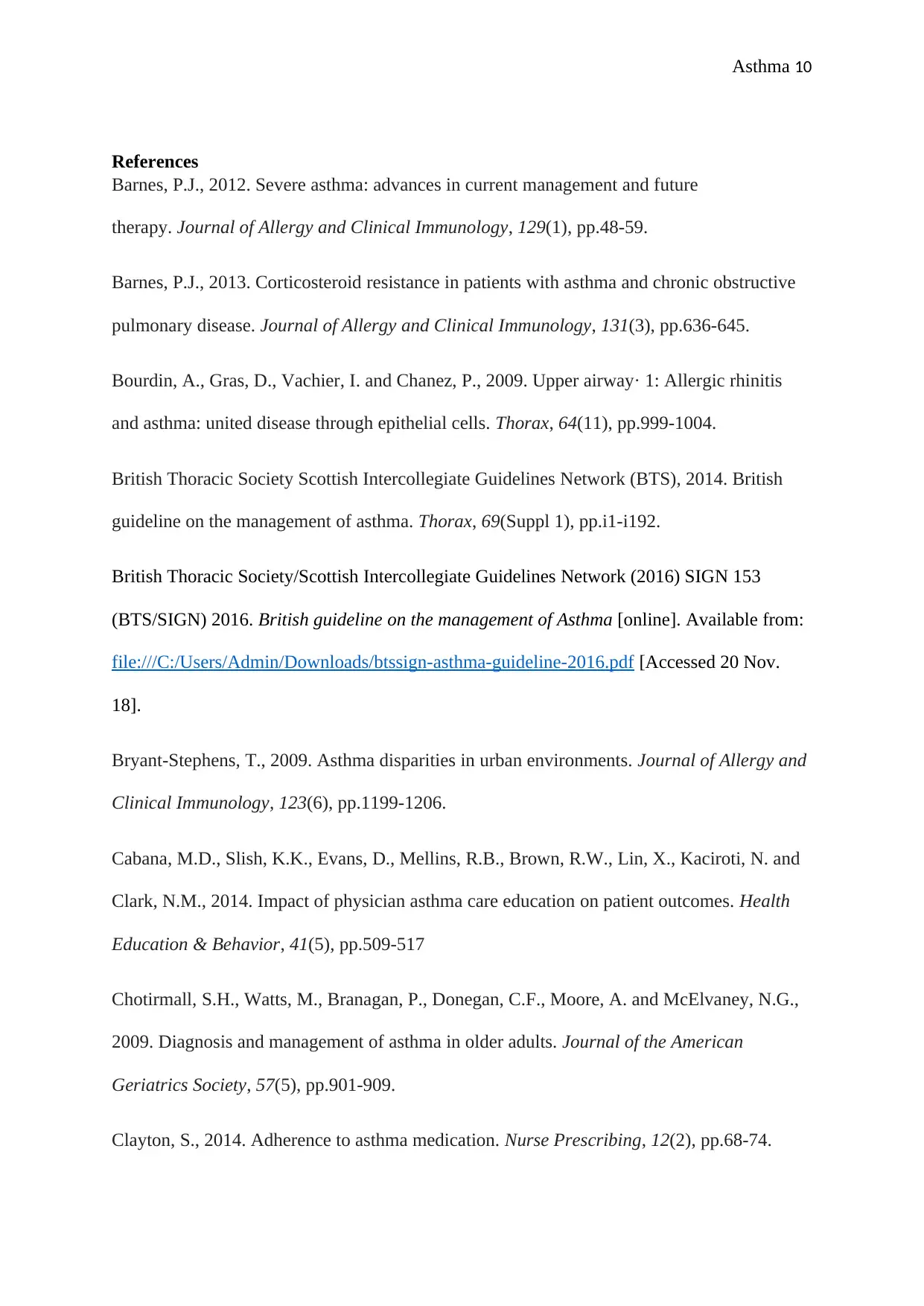
Asthma 10
References
Barnes, P.J., 2012. Severe asthma: advances in current management and future
therapy. Journal of Allergy and Clinical Immunology, 129(1), pp.48-59.
Barnes, P.J., 2013. Corticosteroid resistance in patients with asthma and chronic obstructive
pulmonary disease. Journal of Allergy and Clinical Immunology, 131(3), pp.636-645.
Bourdin, A., Gras, D., Vachier, I. and Chanez, P., 2009. Upper airway· 1: Allergic rhinitis
and asthma: united disease through epithelial cells. Thorax, 64(11), pp.999-1004.
British Thoracic Society Scottish Intercollegiate Guidelines Network (BTS), 2014. British
guideline on the management of asthma. Thorax, 69(Suppl 1), pp.i1-i192.
British Thoracic Society/Scottish Intercollegiate Guidelines Network (2016) SIGN 153
(BTS/SIGN) 2016. British guideline on the management of Asthma [online]. Available from:
file:///C:/Users/Admin/Downloads/btssign-asthma-guideline-2016.pdf [Accessed 20 Nov.
18].
Bryant-Stephens, T., 2009. Asthma disparities in urban environments. Journal of Allergy and
Clinical Immunology, 123(6), pp.1199-1206.
Cabana, M.D., Slish, K.K., Evans, D., Mellins, R.B., Brown, R.W., Lin, X., Kaciroti, N. and
Clark, N.M., 2014. Impact of physician asthma care education on patient outcomes. Health
Education & Behavior, 41(5), pp.509-517
Chotirmall, S.H., Watts, M., Branagan, P., Donegan, C.F., Moore, A. and McElvaney, N.G.,
2009. Diagnosis and management of asthma in older adults. Journal of the American
Geriatrics Society, 57(5), pp.901-909.
Clayton, S., 2014. Adherence to asthma medication. Nurse Prescribing, 12(2), pp.68-74.
References
Barnes, P.J., 2012. Severe asthma: advances in current management and future
therapy. Journal of Allergy and Clinical Immunology, 129(1), pp.48-59.
Barnes, P.J., 2013. Corticosteroid resistance in patients with asthma and chronic obstructive
pulmonary disease. Journal of Allergy and Clinical Immunology, 131(3), pp.636-645.
Bourdin, A., Gras, D., Vachier, I. and Chanez, P., 2009. Upper airway· 1: Allergic rhinitis
and asthma: united disease through epithelial cells. Thorax, 64(11), pp.999-1004.
British Thoracic Society Scottish Intercollegiate Guidelines Network (BTS), 2014. British
guideline on the management of asthma. Thorax, 69(Suppl 1), pp.i1-i192.
British Thoracic Society/Scottish Intercollegiate Guidelines Network (2016) SIGN 153
(BTS/SIGN) 2016. British guideline on the management of Asthma [online]. Available from:
file:///C:/Users/Admin/Downloads/btssign-asthma-guideline-2016.pdf [Accessed 20 Nov.
18].
Bryant-Stephens, T., 2009. Asthma disparities in urban environments. Journal of Allergy and
Clinical Immunology, 123(6), pp.1199-1206.
Cabana, M.D., Slish, K.K., Evans, D., Mellins, R.B., Brown, R.W., Lin, X., Kaciroti, N. and
Clark, N.M., 2014. Impact of physician asthma care education on patient outcomes. Health
Education & Behavior, 41(5), pp.509-517
Chotirmall, S.H., Watts, M., Branagan, P., Donegan, C.F., Moore, A. and McElvaney, N.G.,
2009. Diagnosis and management of asthma in older adults. Journal of the American
Geriatrics Society, 57(5), pp.901-909.
Clayton, S., 2014. Adherence to asthma medication. Nurse Prescribing, 12(2), pp.68-74.
Paraphrase This Document
Need a fresh take? Get an instant paraphrase of this document with our AI Paraphraser
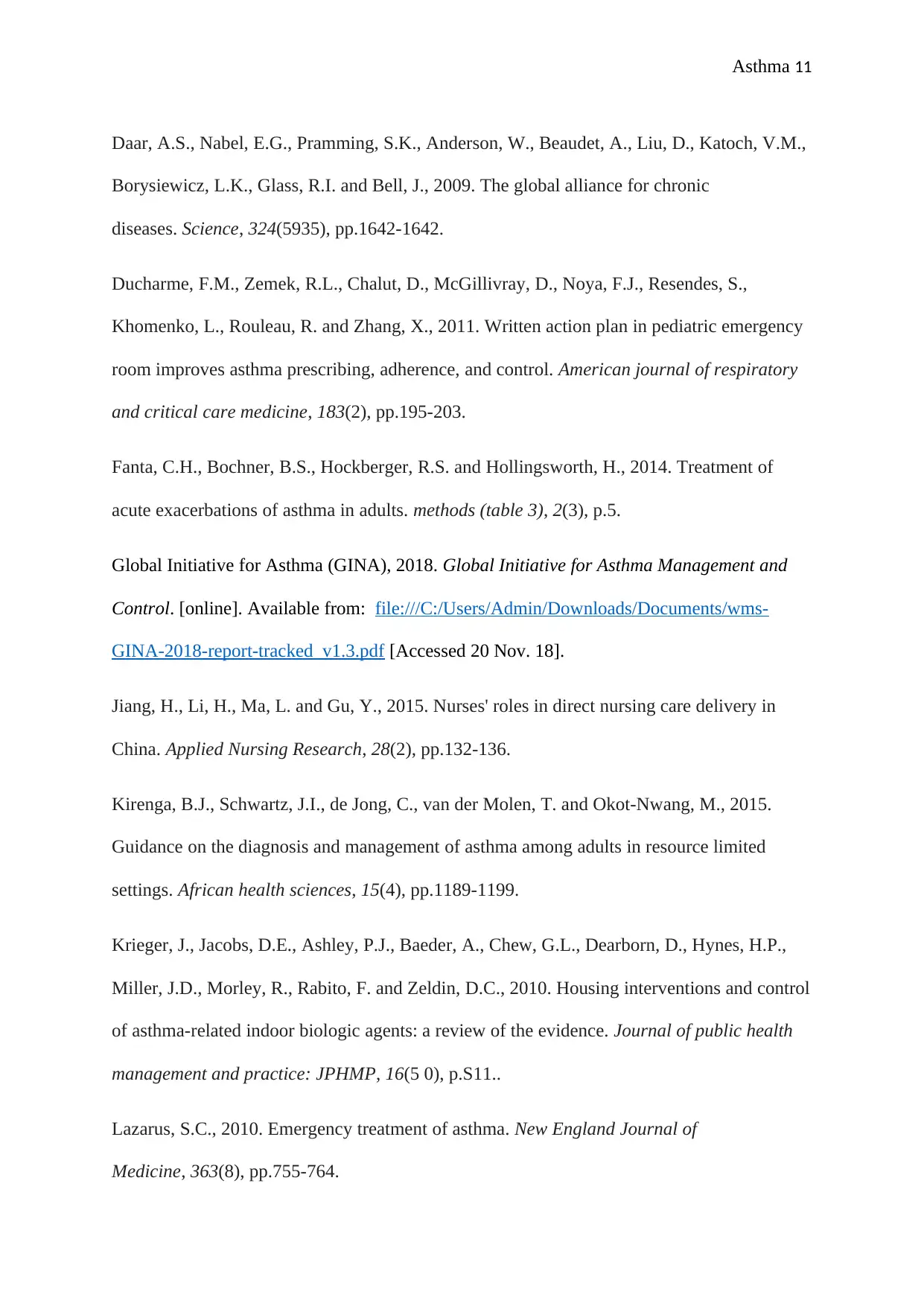
Asthma 11
Daar, A.S., Nabel, E.G., Pramming, S.K., Anderson, W., Beaudet, A., Liu, D., Katoch, V.M.,
Borysiewicz, L.K., Glass, R.I. and Bell, J., 2009. The global alliance for chronic
diseases. Science, 324(5935), pp.1642-1642.
Ducharme, F.M., Zemek, R.L., Chalut, D., McGillivray, D., Noya, F.J., Resendes, S.,
Khomenko, L., Rouleau, R. and Zhang, X., 2011. Written action plan in pediatric emergency
room improves asthma prescribing, adherence, and control. American journal of respiratory
and critical care medicine, 183(2), pp.195-203.
Fanta, C.H., Bochner, B.S., Hockberger, R.S. and Hollingsworth, H., 2014. Treatment of
acute exacerbations of asthma in adults. methods (table 3), 2(3), p.5.
Global Initiative for Asthma (GINA), 2018. Global Initiative for Asthma Management and
Control. [online]. Available from: file:///C:/Users/Admin/Downloads/Documents/wms-
GINA-2018-report-tracked_v1.3.pdf [Accessed 20 Nov. 18].
Jiang, H., Li, H., Ma, L. and Gu, Y., 2015. Nurses' roles in direct nursing care delivery in
China. Applied Nursing Research, 28(2), pp.132-136.
Kirenga, B.J., Schwartz, J.I., de Jong, C., van der Molen, T. and Okot-Nwang, M., 2015.
Guidance on the diagnosis and management of asthma among adults in resource limited
settings. African health sciences, 15(4), pp.1189-1199.
Krieger, J., Jacobs, D.E., Ashley, P.J., Baeder, A., Chew, G.L., Dearborn, D., Hynes, H.P.,
Miller, J.D., Morley, R., Rabito, F. and Zeldin, D.C., 2010. Housing interventions and control
of asthma-related indoor biologic agents: a review of the evidence. Journal of public health
management and practice: JPHMP, 16(5 0), p.S11..
Lazarus, S.C., 2010. Emergency treatment of asthma. New England Journal of
Medicine, 363(8), pp.755-764.
Daar, A.S., Nabel, E.G., Pramming, S.K., Anderson, W., Beaudet, A., Liu, D., Katoch, V.M.,
Borysiewicz, L.K., Glass, R.I. and Bell, J., 2009. The global alliance for chronic
diseases. Science, 324(5935), pp.1642-1642.
Ducharme, F.M., Zemek, R.L., Chalut, D., McGillivray, D., Noya, F.J., Resendes, S.,
Khomenko, L., Rouleau, R. and Zhang, X., 2011. Written action plan in pediatric emergency
room improves asthma prescribing, adherence, and control. American journal of respiratory
and critical care medicine, 183(2), pp.195-203.
Fanta, C.H., Bochner, B.S., Hockberger, R.S. and Hollingsworth, H., 2014. Treatment of
acute exacerbations of asthma in adults. methods (table 3), 2(3), p.5.
Global Initiative for Asthma (GINA), 2018. Global Initiative for Asthma Management and
Control. [online]. Available from: file:///C:/Users/Admin/Downloads/Documents/wms-
GINA-2018-report-tracked_v1.3.pdf [Accessed 20 Nov. 18].
Jiang, H., Li, H., Ma, L. and Gu, Y., 2015. Nurses' roles in direct nursing care delivery in
China. Applied Nursing Research, 28(2), pp.132-136.
Kirenga, B.J., Schwartz, J.I., de Jong, C., van der Molen, T. and Okot-Nwang, M., 2015.
Guidance on the diagnosis and management of asthma among adults in resource limited
settings. African health sciences, 15(4), pp.1189-1199.
Krieger, J., Jacobs, D.E., Ashley, P.J., Baeder, A., Chew, G.L., Dearborn, D., Hynes, H.P.,
Miller, J.D., Morley, R., Rabito, F. and Zeldin, D.C., 2010. Housing interventions and control
of asthma-related indoor biologic agents: a review of the evidence. Journal of public health
management and practice: JPHMP, 16(5 0), p.S11..
Lazarus, S.C., 2010. Emergency treatment of asthma. New England Journal of
Medicine, 363(8), pp.755-764.
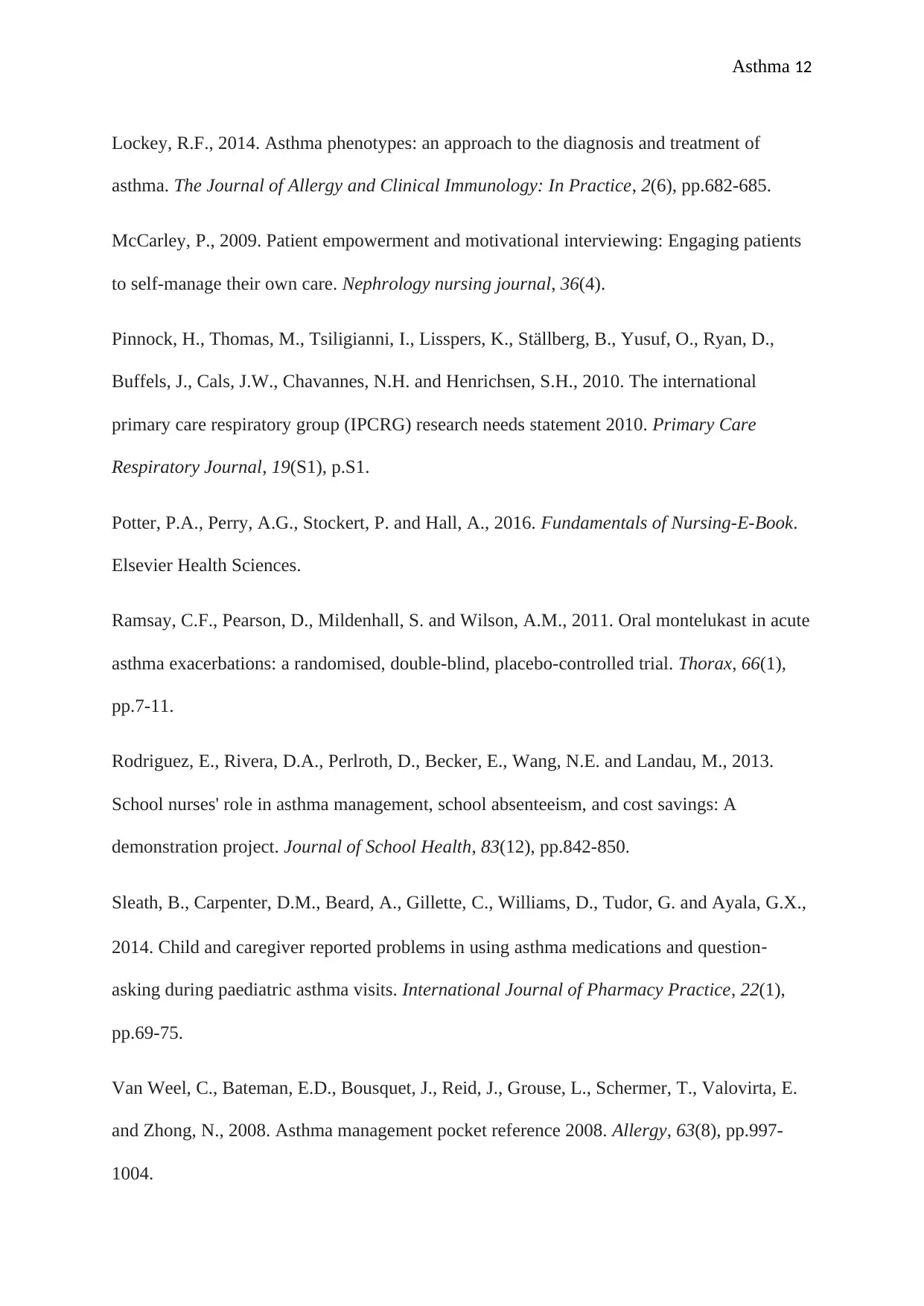
Asthma 12
Lockey, R.F., 2014. Asthma phenotypes: an approach to the diagnosis and treatment of
asthma. The Journal of Allergy and Clinical Immunology: In Practice, 2(6), pp.682-685.
McCarley, P., 2009. Patient empowerment and motivational interviewing: Engaging patients
to self-manage their own care. Nephrology nursing journal, 36(4).
Pinnock, H., Thomas, M., Tsiligianni, I., Lisspers, K., Ställberg, B., Yusuf, O., Ryan, D.,
Buffels, J., Cals, J.W., Chavannes, N.H. and Henrichsen, S.H., 2010. The international
primary care respiratory group (IPCRG) research needs statement 2010. Primary Care
Respiratory Journal, 19(S1), p.S1.
Potter, P.A., Perry, A.G., Stockert, P. and Hall, A., 2016. Fundamentals of Nursing-E-Book.
Elsevier Health Sciences.
Ramsay, C.F., Pearson, D., Mildenhall, S. and Wilson, A.M., 2011. Oral montelukast in acute
asthma exacerbations: a randomised, double-blind, placebo-controlled trial. Thorax, 66(1),
pp.7-11.
Rodriguez, E., Rivera, D.A., Perlroth, D., Becker, E., Wang, N.E. and Landau, M., 2013.
School nurses' role in asthma management, school absenteeism, and cost savings: A
demonstration project. Journal of School Health, 83(12), pp.842-850.
Sleath, B., Carpenter, D.M., Beard, A., Gillette, C., Williams, D., Tudor, G. and Ayala, G.X.,
2014. Child and caregiver reported problems in using asthma medications and question‐
asking during paediatric asthma visits. International Journal of Pharmacy Practice, 22(1),
pp.69-75.
Van Weel, C., Bateman, E.D., Bousquet, J., Reid, J., Grouse, L., Schermer, T., Valovirta, E.
and Zhong, N., 2008. Asthma management pocket reference 2008. Allergy, 63(8), pp.997-
1004.
Lockey, R.F., 2014. Asthma phenotypes: an approach to the diagnosis and treatment of
asthma. The Journal of Allergy and Clinical Immunology: In Practice, 2(6), pp.682-685.
McCarley, P., 2009. Patient empowerment and motivational interviewing: Engaging patients
to self-manage their own care. Nephrology nursing journal, 36(4).
Pinnock, H., Thomas, M., Tsiligianni, I., Lisspers, K., Ställberg, B., Yusuf, O., Ryan, D.,
Buffels, J., Cals, J.W., Chavannes, N.H. and Henrichsen, S.H., 2010. The international
primary care respiratory group (IPCRG) research needs statement 2010. Primary Care
Respiratory Journal, 19(S1), p.S1.
Potter, P.A., Perry, A.G., Stockert, P. and Hall, A., 2016. Fundamentals of Nursing-E-Book.
Elsevier Health Sciences.
Ramsay, C.F., Pearson, D., Mildenhall, S. and Wilson, A.M., 2011. Oral montelukast in acute
asthma exacerbations: a randomised, double-blind, placebo-controlled trial. Thorax, 66(1),
pp.7-11.
Rodriguez, E., Rivera, D.A., Perlroth, D., Becker, E., Wang, N.E. and Landau, M., 2013.
School nurses' role in asthma management, school absenteeism, and cost savings: A
demonstration project. Journal of School Health, 83(12), pp.842-850.
Sleath, B., Carpenter, D.M., Beard, A., Gillette, C., Williams, D., Tudor, G. and Ayala, G.X.,
2014. Child and caregiver reported problems in using asthma medications and question‐
asking during paediatric asthma visits. International Journal of Pharmacy Practice, 22(1),
pp.69-75.
Van Weel, C., Bateman, E.D., Bousquet, J., Reid, J., Grouse, L., Schermer, T., Valovirta, E.
and Zhong, N., 2008. Asthma management pocket reference 2008. Allergy, 63(8), pp.997-
1004.
⊘ This is a preview!⊘
Do you want full access?
Subscribe today to unlock all pages.

Trusted by 1+ million students worldwide
1 out of 19
Related Documents
Your All-in-One AI-Powered Toolkit for Academic Success.
+13062052269
info@desklib.com
Available 24*7 on WhatsApp / Email
![[object Object]](/_next/static/media/star-bottom.7253800d.svg)
Unlock your academic potential
Copyright © 2020–2025 A2Z Services. All Rights Reserved. Developed and managed by ZUCOL.





